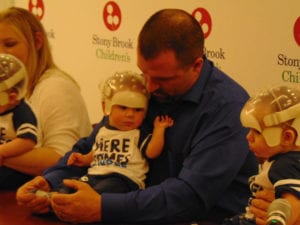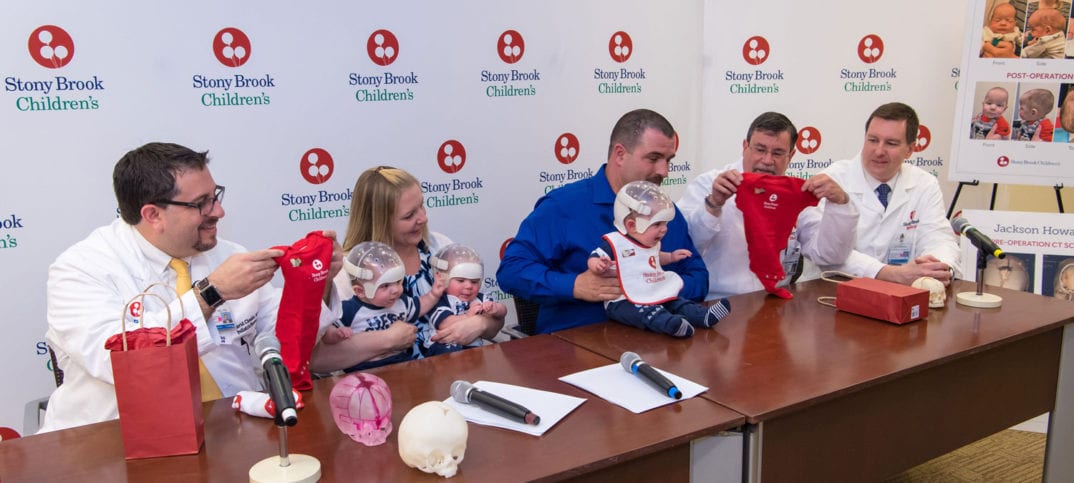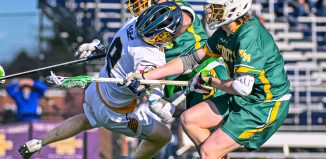By Rita J. Egan
When Center Moriches residents Amy and Mike Howard discovered she was pregnant with triplets, they never imagined how unique their children would be. All three babies, Hunter and Jackson, who are identical, and Kaden, who is fraternal, were born with craniosynostosis.
The medical condition, a congenital premature fusion of one or more sutures on a baby’s skull, changes the growth pattern of the skull causing an abnormal head shape. If not surgically repaired it could increase the chances of intracranial hypertension, which could lead to visual impairment or impaired mental development.

At a May 1 press conference at Stony Brook University Hospital, the six-month-old boys were introduced to the world, accompanied by their parents and their surgeons Dr. David Chesler, assistant professor of neurosurgery, and Dr. Elliot Duboys, associate professor of plastic surgery. The procedure, which took place at Stony Brook Children’s Hospital in early January, was the first-ever reported of its kind where all three triplets had craniosynostosis.
“It’s not that uncommon with twins or multiple births that one child have [craniosynostosis] and the other not,” Chesler said. “The fact that all three of them had it was pretty unique.”
While the condition occurs in about one out of every 2,100 births, Chesler said he and Duboys were working out the numbers to see what the odds were for all three in a set of triplets to have craniosynostosis, and they estimated the chances are one in 500 trillion.
Chesler said when Kaden was born his head looked triangular while Hunter’s and Jackson’s skulls protruded in the back. The doctor explained the difference in a normal skull compared to one with craniosynostosis.
“It means that their skulls have just fused a little bit earlier,” he said. “Our skulls are normally a set of plates. They’re not one big bone, and the skull grows as a consequence of that.”
The infants wore custom-fit helmets to the press conference, which they are required to wear 23 hours a day and will continue to wear for another three months. The helmets help to guide and mold the shape of their skulls as they grow. Their mother said she cleans the helmets once a day, sometimes twice, when she washes the children’s hair, and they don’t seem to be bothered by them as they go about their everyday activities. They can even sleep with them on.
“The first two weeks when we brought them home with the helmets they didn’t like it but now it’s like putting on a baseball cap for them,” the boys’ father said.
Chesler said without the helmet the bone would grow back and then the problem that created their abnormal head shape in the beginning is reestablished.
Amy said the triplets were her first pregnancy and when she first found out she was pregnant in March 2016 the doctor told her there was only one embryo. Three weeks later when she went for her nine-week checkup, the doctor informed her she saw three babies on the sonogram. Since her doctor doesn’t deliver multiples, the new mother came to Stony Brook University Hospital, where she and her husband were alerted of the various things to watch for when dealing with a high-risk pregnancy. However, after an uneventful pregnancy doctors delivered the triplets six weeks early, Oct. 22.
“The first two weeks when we brought them home with the helmets they didn’t like it but now it’s like putting on a baseball cap for them.”
— Mike Howard
It was after the triplets’ birth that the Howards discovered their babies had craniosynostosis. Their mother said you could tell their heads were malformed.
“It was really extremely scary just thinking about having your eight- or nine-week-old baby going through surgery and having their bones cut open,” Howard said.
Chesler said while there are a number of ways to conduct the operation, when he started working at the hospital in 2014, he introduced a minimally invasive endoscopic surgery for the condition. The doctor said the surgery involves less bone being removed and less loss of blood than the alternative, open-skull surgery. The procedure takes about two hours, and the patients can go home 24 to 48 hours later.
While Kaden had the rarest form of craniosynostosis — metopic synostosis — and Hunter and Jackson had the most common form — sagittal synostosis — their surgeries were similar.
The procedure involves a small incision being made in the patient’s head, and then using an endoscope and scalpel a strip of bone is cut to remove the fused seam. This is considered a better option over the open-skull surgery, which can require a few hours of surgery and five days of recovery at the hospital. There is also less of a need for a transfusion with the endoscope surgery.
Duboys said in Kaden’s case, metopic sutures usually fuse in three to six months, but in the baby’s case it fused while he was in the uterus. With Hunter and Jackson, the sutures that fused while in the uterus usually fuse in adulthood. He said the endoscope surgery can be done much earlier than the open-skull surgery.
Duboys said they have operated on several hundred children using the open operation, and he said the endoscope procedure allows them to operate on younger children.
“Now at Stony Brook, and with Dr. Chesler, we’re able to offer both,” the doctor said. “In Dr. Chesler’s case, usually it is much better in the younger ages.”
Hunter and Jackson were able to go home after two days in the hospital and Kaden spent just one. The doctors performed the procedures on Hunter and Jackson the first day and Kaden on the second so they could all go home together. After the surgery, the three only needed Tylenol for a week, and the parents said they didn’t think their children were in much pain.
The Howards said the children have been meeting all their development milestones, and their mother added, “Hunter and Kaden are shooting up their growth chart.”







